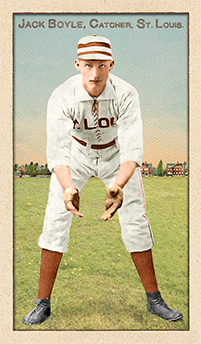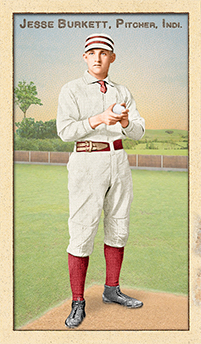- Series: Beginnings: 1880's
- City: St. Louis
- Team: Browns (AA)
- League: American Association
John Anthony Boyle (1866-1913) debuted with the Red Stockings in 1886 for one game before being traded to Comiskey’s Browns. Jack became their regular catcher when Doc Bushong got hurt. Comiskey then took Boyle with him to the Players’ League Chicago Pirates for the 1890 season and then back to St. Louis when that venture collapsed. Sold to NY in ‘92, Jack became the “giant” of the team at 6’4”. The Giants used Jack and others to reclaim HOF’er Roger Connor from the Phillies the following year. Boyle finished his ML tenure with the Phils where he had his best years at bat. As he gained experience behind the plate, Jack’s defense measured up to his strong offense.
- Boyle compiled a career .253 average and fielded .929 overall, mostly as a durable catcher
- Per SABR, “Honest Jack’s” trade to the Browns was the very first in the major leagues
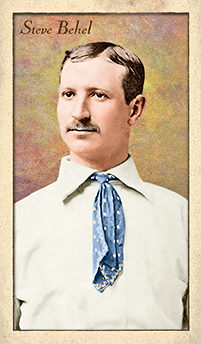
- Series: 1880s: Spotted Ties
- City: New York
- Team: Metropolitans
- League: American Association
Stephen Arnold Douglas Behel (1860-1945) had a life that spanned a remarkable period, from the eve of the Civil War to nearly the end of World War II. He only spent a few years out of those nine decades in professional baseball, but he could tell his grandchildren about how he was once a big league player.
Behel saw action in nine games in 1884 for the Milwaukee Brewers of the upstart Union Association, which had poached players from the dominant National League, the American Association and minor league teams. The UA managed to limp through that one season at the pinnacle of the game, though many decry the notion that it was truly a major league. The Brewers only played a dozen games in '84 as a replacement franchise late in the season along with the St. Paul Saints. The Saints never got to play a home game and the Brewers (aka Cream Citys) played only one on the road. Steve went 8 for 33, good for a .242 average which was third on the team.
Behel was a part-timer for the AA's NY Metropolitans in 1886, playing in 59 games, but his average slipped to .205. Primarily a minor leaguer, Behel began with the Fort Wayne Hoosiers of the Northwestern League in 1883 and concluded with Rockford of the Central Interstate League in 1888. His best season was with Eau Claire, where he batted .348 in 1887.
- The Earlville, IL native played most of his pro ball close to home, but he did get further afield with the Augusta Browns of the Southern League in 1885
Auction History
Cartophilia
Old Judge Pose: 26-1
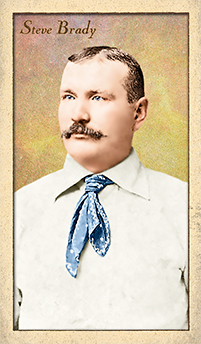
- Series: 1880s: Spotted Ties
- City: New York
- Team: Metropolitans
- League: American Association
Stephen A. Brady (1851-1917) was born in Worcester, MA and began playing professional ball in New England in the early days of the sport's arrival on the national scene. Brady started out with the Hartford Dark Blues of the pre-modern majors - the National Association of Professional Base Ball Players. The NAPBBP had become the first openly pro league in 1871 and Steve joined the fraternity the same year the Hartfords did, 1874.
Seven eastern seaboard clubs plus Chicago made up the circuit that year. Owned and organized by Morgan Bulkeley and anchored by the likes of Cherokee Fisher, Bob Addy, Orator Shafer and Lip Pike, Hartford’s Dark Blues disappointed and dwelt near the cellar in 1874, finishing with a 16-37 record as the Boston Red Stockings continued their dominance. Rookie Brady did well in a utility role however, contributing a .314 average in 27 games to an otherwise dismal season.
Brady would play only one game for the Dark Blues in 1875 before being shipped off to the Washington Nationals. The move was likely regrettable for him professionally. The Nationals would go 5-23 and bankrupt while his former Dark Blues dominated at 54-28 on the strength of contributions from a few newly acquired superstars. Tommy Bond and Candy Cummings won those 54 games with a combined ERA of 1.56 while the team, including recently acquired sluggers Black Jack Burdock and Tom York, flourished under the leadership and defensive wizardry of new player/manager Bob “Death to Flying Things” Ferguson.
Meanwhile, Brady’s performance in Washington mirrored his team’s: he floundered with a .143 batting average for a club that produced a .179 winning percentage. The minors soon beckoned and Steve played for NY and MA clubs, including the Metropolitans whom he joined for the 1881 season in the Eastern Championship Association. The team moved to the League Alliance and, in '83, ascended to the American Association, returning Brady to the majors through 1886. Moved to the outfield in '84, Steve's offensive production stabilized and he batted .264 over his tenure in NY. By 1887 Brady's old Hartford team was now in the Eastern League when he rejoined them for a very successful season, hitting .350.
- Per Wikipedia: Brady’s 1875 Washington Nationals "went out of business in St. Louis, Missouri, after playing the local Red Stockings on July 3 and July 4. Next day the players announced by telegraph that a club official had absconded with the funds but (Ryczek 1992: 194) concludes that "the tale had been planted by the players in an effort to find enough good samaritans to foot the bill for the trip home." The club probably failed by "unappealing play" and consequent receipts too small to support travel. On the final trip, they lost two in Philadelphia and five of six in St. Louis. The final game was a 12-5 victory but the two local teams outscored Washington 42-5 in the first five games, which must have been repelling."
Auction History
Cartophilia
Old Judge Pose: 39-1
- Series: Beginnings: 1880's
- City: Indianapolis
- Team: Hoosiers (NL)
- League: National League
- Hall: National Baseball Hall of Fame
Jesse “the Crab” Burkett (1868-1953) was a Hall of Fame outfielder from 1890 to 1905. Following Ed Delahanty, Burkett became the second major leaguer to hit .400 twice (‘95 &’96 for the Cleveland Spiders.) Led the NL with .376 in 1901 while with the St Louis Cardinals.
- Still holds MLB record for inside-the-park HRs with 55
- First West Virginian elected to Hall of Fame
- Elected to Hall of Fame: 1946
- Jesse Burkett did not appear in the Old Judge series. This image is taken from a photo that appeared in The Sporting Times in February, 1890. Signed by Indianapolis as a young pitching phenom after the close of the 1889 season, Burkett would never pitch for the Hoosiers as the franchise folded before the 1890 season. Burkett then made his major league debut with the New York Giants in 1890 on a pitching staff that included Amos Rusie and Mickey Welch.
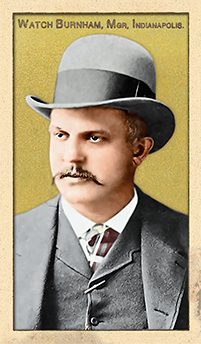
- Series: Beginnings: 1880's
- City: Indianapolis
- Team: Hoosiers (NL)
- League: National League
George Walter Burnham (1860-1902) was lured from the ranks of National League umpires to become the first manager of the new Indianapolis Hoosiers franchise when John Brush brought the beleaguered St Louis Maroons to a joyous community. “Watch” thus became a key figure in the sad saga of major league baseball in Indiana. The club lost every one of its arduous 22-game road trip and floundered all of the 1887 inaugural year. Burnham thought fining all the players might improve morale but captain Jack Glasscock mutinied. The Chicago Tribune reported the fear that “someday the men will decline to go on the field.” Days later Brush replaced Watch with another manager with no playing or managing experience and would try yet another neophyte, a sportswriter, before that dismal season mercifully ended with a 37-89 record. Burnham’s reputation preceded him to the Hoosiers and gave pause. The nickname was said to have derived from George’s failed attempt at self-promotion by presenting himself with an engraved watch during a Cleveland game in ‘83 that he was umpiring.
- Watch’s total experience officiating was 107 games scattered over five seasons between ‘83 and ‘95. He called Old Hoss Radbourn’s no-hitter on July 25, 1883
- The Hoosiers’ prospect finally seemed ready to improve in 1889 with the arrival of Amos Rusie. Sadly for the city, Brush parlayed his investment into a lucrative career with the Reds and Giants by dumping the woebegone Hoosiers after their third losing season
